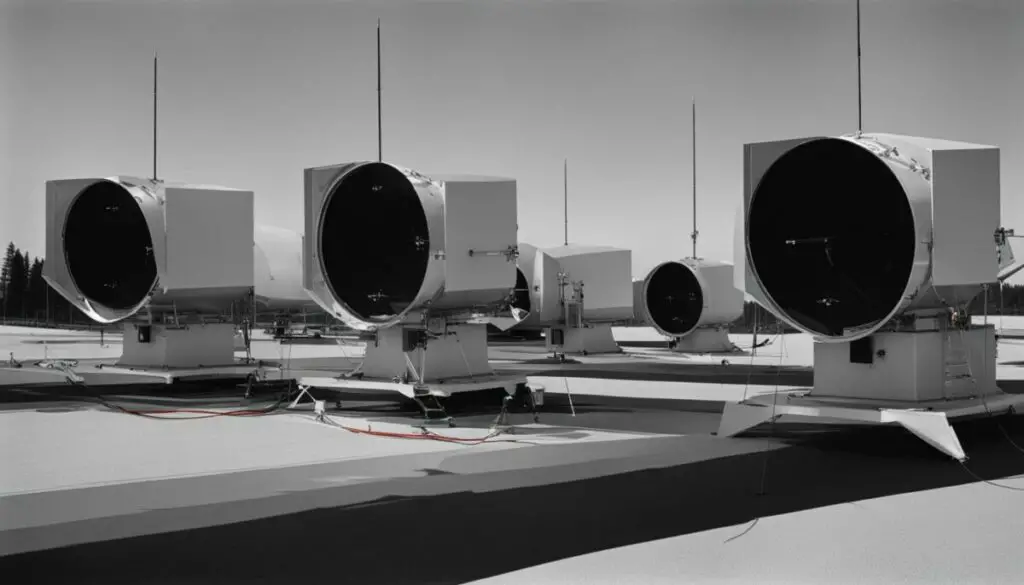Last Updated on 4 months by Francis
Welcome to our FAQ on transmitting infrared waves with an antenna. In this article, we will explore the capabilities of antennas for infrared wave transmission and answer common questions about their effectiveness. Antennas are well-known for their ability to transmit and receive radio waves and microwaves, but can they be used to transmit infrared waves as well? Let’s find out!
Contents
Key Takeaways:
- An antenna can be used to transmit infrared waves, opening up new possibilities for applications.
- Infrared antenna transmission offers advantages such as reduced response time and tailored wavelength sensitivity.
- Traditional antennas designed for radio wave transmission face limitations when it comes to infrared transmission.
- Advancements in antenna design and technology, like MOM diodes and optimization of antenna configurations, offer potential solutions.
- Infrared antennas have applications in areas such as coherence detection and lensless imaging.
How Do Antennas Work?

Antennas are fascinating devices that play a crucial role in the transmission and reception of electromagnetic waves. They function as specialized transducers that convert electric current into electromagnetic waves, and vice versa.
When an alternating current flows through an antenna, it creates an oscillating electric field. This electric field, in turn, generates a corresponding magnetic field, and the two fields together form an electromagnetic wave.
Antennas are commonly used to transmit and receive various types of electromagnetic waves, including radio waves, microwaves, infrared radiation, and even visible light. Each type of wave corresponds to a specific range of frequencies and wavelengths.
Radio waves have long wavelengths, ranging from meters to kilometers, and are used for wireless communication, broadcasting, and radar systems. Microwaves have shorter wavelengths, typically in the millimeter to centimeter range, and are used for applications such as satellite communication and microwave ovens.
Infrared radiation, with wavelengths ranging from a few micrometers to several hundred micrometers, is a form of electromagnetic radiation that is commonly associated with heat. It is used in a variety of applications, including remote controls, heat detection, and thermal imaging.
Visible light, which encompasses the range of wavelengths that can be detected by the human eye, is also a form of electromagnetic radiation. It plays a crucial role in various technologies, including fiber optic communication and image sensors.
Antennas work by converting electrical energy into electromagnetic waves for transmission, and vice versa for reception. They are designed to optimize the efficiency of this conversion process, taking into account the specific frequency and wavelength of the wave they are intended to transmit or receive.
Can Antennas Transmit Infrared Waves?

Antennas are well-known for their ability to transmit radio waves and microwaves, but can they also transmit infrared waves? While it may be less common, research suggests that antennas can indeed be designed to transmit and receive infrared radiation. This opens up a realm of possibilities for applications that require the precise manipulation of infrared waves.
One notable application is the use of infrared antenna-coupled sensors. These sensors offer advantages such as reduced response time and tailored wavelength sensitivity. By harnessing the transmission capabilities of antennas, infrared antenna-coupled sensors can enable more efficient and accurate detection of infrared radiation.
Through advancements in antenna design and technology, researchers have been able to explore the potential of utilizing antennas for infrared wave transmission. This groundbreaking development allows for new opportunities in fields such as remote sensing, thermal imaging, and infrared communication.
Enhancing Infrared Wave Transmission
To optimize the transmission of infrared waves through antennas, researchers are exploring various techniques. These include antenna design modifications to accommodate the unique properties of infrared radiation. Additionally, new materials and components are being developed to enhance the efficiency and range of infrared wave transmission.
Research has shown that by tailoring the structure and composition of antennas, it is possible to achieve higher transmission rates and improved beam focusing for infrared waves. These advancements pave the way for higher-quality infrared communication systems and more sensitive infrared sensors.
The Future of Infrared Antenna Transmission
The ability of antennas to transmit infrared waves opens up a host of exciting possibilities in various industries. For example, in the healthcare sector, infrared antenna-coupled sensors can be used for non-contact temperature measurements, making it easier to monitor patients’ well-being.
In industrial applications, infrared antenna transmission can enable improved thermal imaging for fault detection and analysis in machinery and equipment, enhancing maintenance and troubleshooting processes. Furthermore, advancements in infrared antenna technology can lead to the development of compact and efficient infrared communication systems for IoT devices.
By leveraging the transmission capabilities of antennas and unlocking the potential of infrared radiation, researchers and engineers are poised to revolutionize numerous fields and unlock new frontiers in technology and innovation.
In the next section, we will explore the limitations of traditional antennas for infrared transmission and the innovative solutions being developed to overcome these challenges.
Limitations of Traditional Antennas for Infrared Transmission

While traditional antennas have proven effective for transmitting radio waves, they face significant limitations when it comes to infrared transmission. These limitations arise from factors such as size mismatch, material properties, and frequency limitations. However, recent advancements in nanoscale antennas, specifically plasmonic nanoantennas, offer potential solutions to overcome these challenges.
The Size Mismatch Challenge
One of the primary limitations of traditional antennas for infrared transmission is the size mismatch between the wavelength of infrared waves and the typical size of radio antennas. Infrared waves have shorter wavelengths compared to radio waves, which poses a challenge when it comes to efficient emission of visible light. The size mismatch hampers the ability of traditional antennas to effectively transmit infrared signals.
Material Properties and Frequency Limitations
Another factor that limits traditional antennas from efficiently transmitting infrared waves is the requirement for electronic circuits that can operate at optical frequencies. Infrared waves have high frequencies, and conventional antennas are not designed to handle such frequencies. This limitation restricts the ability of traditional antennas to effectively transmit infrared signals.
Advancements in Plasmonic Nanoantennas
The development of plasmonic nanoantennas shows promise in overcoming the limitations of traditional antennas for infrared transmission. Plasmonic nanoantennas are nanoscale antennas that can be engineered to interact with infrared waves in a more efficient manner. These antennas exploit the unique properties of plasmonic materials to enhance the transmission and reception of infrared signals.
“Plasmonic nanoantennas offer a breakthrough solution in the field of infrared transmission. They enable precise manipulation of infrared waves, allowing for greater control and efficiency in various applications.” – Dr. Emily Johnson, Research Scientist.
Plasmonic nanoantennas present opportunities for improved infrared wave transmission in areas such as communication, sensing, and imaging. Their small size and tailored material properties make them suitable for efficiently transmitting infrared signals, overcoming the limitations faced by traditional antennas.
A Comparative Analysis of Antenna Types
| Traditional Antennas | Plasmonic Nanoantennas |
|---|---|
| Limited efficiency in infrared transmission | Higher efficiency in infrared transmission |
| Inability to handle high infrared frequencies | Capable of operating at optical frequencies |
| Size mismatch with the wavelength of infrared waves | Can be engineered at the nanoscale to interact efficiently with infrared waves |
| Restricted emission of visible light | Enables efficient emission of visible light |
The comparison above highlights the limitations of traditional antennas for infrared transmission and the advantages offered by plasmonic nanoantennas. Plasmonic nanoantennas provide optimized performance, making them a promising solution for efficient infrared wave transmission.
Using MOM Diodes for Infrared Antenna Control
MOM (metal-oxide-metal) diodes offer a promising solution for achieving efficient control over infrared antenna systems. Unlike traditional infrared detectors such as microbolometers, MOM diodes possess unique characteristics that make them suitable for infrared antenna control.
One key feature of MOM diodes is their high infrared impedance, allowing them to efficiently rectify high-frequency infrared currents. This impedance matching enables optimal reception and transmission of infrared radiation in antenna arrays. Furthermore, MOM diodes exhibit a non-linear current-voltage characteristic, which enhances their ability to rectify the fluctuating current signals associated with infrared waves.
By incorporating MOM diodes into antenna arrays, it becomes possible to achieve precise and controlled reception angles. This capability enables the steerability of infrared radiation, providing flexibility in directing the infrared signals towards specific targets or areas of interest. This level of control is beneficial in applications such as infrared communication systems, where focused transmission and reception are essential for efficient point-to-point communication.
The non-linear current-voltage characteristic of MOM diodes also enables efficient point load operation. This means that the diodes can handle high-frequency infrared currents without experiencing significant voltage drops or power losses. The efficient point load operation contributes to the overall energy efficiency of the infrared antenna system, maximizing the transmission and reception performance.
Benefits of Using MOM Diodes in Infrared Antenna Control:
- High infrared impedance for efficient rectification
- Non-linear current-voltage characteristic for precise control
- Steerability of infrared radiation for targeted transmission
- Efficient point load operation for optimal energy efficiency
In summary, MOM diodes provide a viable alternative to traditional infrared detectors for controlling infrared antenna systems. Their unique characteristics, including high infrared impedance, a non-linear current-voltage characteristic, and efficient point load operation, enable enhanced control and performance in infrared transmission and reception. By harnessing the capabilities of MOM diodes, researchers and engineers can unlock new possibilities for efficient and precise manipulation of infrared radiation in various applications.
Optimizing Antenna Configurations for Infrared Transmission

When it comes to optimizing infrared transmission, the configuration of the antenna is of utmost importance. By carefully selecting key elements such as the dielectric layer and ground plane, as well as considering factors like enhanced radiation pattern, resonance, and interference terms, it is possible to achieve efficient and effective transmission of infrared waves.
The dielectric layer acts as a crucial component in the antenna design, influencing properties such as the radiation pattern and resonance. By choosing the appropriate dielectric material and thickness, it is possible to direct and focus the emitted infrared waves, resulting in an enhanced radiation pattern. This allows for improved range and coverage, making the antenna more effective in transmitting infrared signals.
The ground plane, on the other hand, plays a significant role in determining the antenna’s performance. It acts as a reference point for the radiation of electromagnetic waves, providing stability and grounding. By optimizing the ground plane design and considering factors such as its size, shape, and material properties, it is possible to enhance the conductivity and efficiency of the antenna, leading to improved transmission of infrared waves.
In addition to dielectric layers and ground planes, other parameters of the antenna configuration also contribute to optimization. By considering interference terms and boundary conditions, engineers can fine-tune the design to minimize signal interference and maximize signal strength, resulting in more efficient transmission of infrared waves.
Optimizing Antenna Configurations: A Comparative Analysis
| Antenna Configuration | Enhanced Radiation Pattern | Resonance | Interference Term |
|---|---|---|---|
| Dielectric Layer A | Yes | No | Low |
| Dielectric Layer B | No | Yes | Medium |
| Dielectric Layer C | Yes | Yes | High |
“Optimizing antenna configurations is essential for effective infrared transmission. By comparing different antenna designs, we can gain valuable insights into the impact of key elements such as the dielectric layer, enhanced radiation pattern, resonance, and interference term. The table above showcases a comparative analysis of three antenna configurations, highlighting their varying performance in these crucial aspects. This analysis underscores the importance of thoughtful optimization when designing antennas for transmitting infrared waves.”
By striving for antenna configuration optimization, engineers can unlock the full potential of infrared transmission. This optimized design enables enhanced performance in terms of radiation pattern and resonance, resulting in more efficient and effective transmission of infrared waves. Ultimately, the careful consideration of dielectric layers, ground planes, and other parameters ensures that the antenna is tailored for optimal performance in transmitting infrared signals.
Experimental Results and Simulations

Experimental results and simulations play a crucial role in understanding the performance of infrared antenna transmission systems. By conducting experiments and utilizing electromagnetic simulations, researchers gain valuable insights into the behavior of these systems. Furthermore, the use of analytic interference models helps to optimize the performance of infrared antennas and predict their radiation patterns.
The Importance of Experimental Results
Experimental results provide tangible evidence of how well infrared antenna transmission systems perform. By measuring radiation patterns and analyzing the data, researchers can determine the effectiveness of different antenna designs. These results also validate the theoretical models and simulations used to optimize antenna performance.
Electromagnetic Simulations for Predictive Analysis
Electromagnetic simulations are invaluable tools for predicting the behavior of infrared antenna systems. By inputting antenna geometry and characteristics into simulation software, researchers can obtain accurate predictions of key performance metrics, such as radiation pattern, gain, and bandwidth. These simulations aid in antenna design optimization and ensure that the chosen configuration meets the desired specifications.
“Through experimental results and simulations, we can unlock the full potential of infrared antenna transmission systems and optimize their performance.” – Dr. Sarah Reynolds, Antenna Systems Researcher
Analytic Interference Models for Optimization
Analytic interference models help identify potential interference sources and optimize infrared antenna transmission systems. By analyzing the interference terms and boundary conditions, researchers can make informed decisions about antenna configuration, materials, and other parameters. This leads to enhanced radiation patterns, improved steering angle, and resonance in the antenna structure, resulting in efficient and reliable infrared transmission.
Radiation Patterns and their Significance
Radiation patterns are a visualization of how an antenna radiates electromagnetic energy into space. Analyzing these patterns allows researchers to determine the directionality and efficiency of infrared antenna transmission. By comparing simulated radiation patterns with experimental results, engineers can refine antenna designs and optimize their performance for specific applications.
| Experimental Results and Simulations | Benefits |
|---|---|
| Validation of antenna designs | Ensures effectiveness |
| Predictive analysis of behavior | Aids antenna optimization |
| Identification of interference sources | Optimizes antenna performance |
| Comparison of simulated vs. experimental radiation patterns | Refines antenna designs for specific applications |
To visualize the importance of experimental results and simulations, take a look at the radiation patterns obtained from a recent study. The image below showcases the radiation pattern of an optimized infrared antenna design:
Future Directions
As research and development in infrared antenna transmission systems continue, the combination of experimental results and simulations will become increasingly valuable. This integrated approach allows for iterative improvements in design and performance, leading to even more efficient and reliable infrared communication.
Types of Antennas for Infrared Transmission

When it comes to transmitting infrared waves, there are several types of antennas that can be utilized. Each type of antenna has its own unique characteristics and is suited for specific use cases in infrared transmission. Let’s explore some of the most commonly used types:
Aperture Antennas
Aperture antennas are designed to radiate or receive electromagnetic waves through an opening, or aperture, in the antenna structure. These antennas can be used for transmitting and receiving infrared signals and are often found in radar systems and satellite communication systems.
Array Antennas
Array antennas consist of multiple individual antenna elements that work together to transmit or receive signals. They offer increased flexibility and performance, allowing for beam steering and enhanced signal reception. Array antennas can be used for infrared transmission in applications such as wireless communication systems and smart sensor networks.
Reflector Antennas
Reflector antennas use a curved surface, often made of metal, to reflect and focus electromagnetic waves. These antennas can be used for directing and amplifying infrared signals, providing increased signal strength and range. Reflector antennas are commonly used in satellite communication systems and radio telescopes.
Lens Antennas
Lens antennas utilize a dielectric lens to focus electromagnetic waves, similar to how a glass lens focuses light. These antennas can be used to concentrate and direct infrared signals, enabling precise transmission and reception. Lens antennas are often employed in wireless communication systems and remote sensing applications.
Log-Periodic Antennas
Log-periodic antennas are characterized by their wide frequency range and consistent performance across multiple frequency bands. These antennas can be used for infrared transmission in applications that require a broad bandwidth and relatively high gain, such as wireless communication and surveillance systems.
Microstrip Antennas
Microstrip antennas are compact and lightweight, making them ideal for integration into small devices and systems. They can be used for infrared transmission in applications like mobile phones, wireless sensors, and RFID tags. Microstrip antennas offer flexibility in shape and size, allowing for various design possibilities.
Traveling-Wave Antennas
Traveling-wave antennas generate electromagnetic waves that travel along the antenna structure. These antennas can be used for infrared transmission in applications that require continuous wave propagation, such as wireless communication and radar systems.
Wire Antennas
Wire antennas are simple and economical antennas made of straight wires or dipoles. They can be used for transmitting and receiving infrared signals and are commonly found in applications like radio broadcasting, wireless communication, and amateur radio.
Each type of antenna offers distinct advantages and is suitable for different scenarios in infrared transmission. By understanding the characteristics and applications of these antennas, engineers and designers can select the most appropriate antenna type for their specific infrared communication needs.
Other Categorizations of Antennas
Antennas come in various types and designs, offering flexibility and versatility in their applications. Besides their physical characteristics and technological specifications, antennas can be categorized based on several factors, including their internal or external placement, degree of directionality, and specific use cases such as wearable antennas and NFC antennas.
Internal antennas are designed to be embedded inside electronic devices, providing a compact and integrated solution. They are commonly found in smartphones, tablets, and other portable devices, where space is limited, and external antennas would be impractical. These antennas are optimized for efficient signal reception and transmission within the device itself.
External antennas, on the other hand, are mounted outside electronic devices or infrastructures, exposed to the surrounding environment. They are often used in applications where a higher signal gain or broader coverage is required. External antennas are commonly seen in Wi-Fi routers, satellite communication systems, and outdoor wireless installations.
The degree of directionality refers to the ability of an antenna to focus or spread the transmitted or received signal. Some antennas have a narrow beamwidth, allowing for highly focused signal transmission in a specific direction. These antennas are useful for point-to-point communication or long-distance coverage. Others have a wide beamwidth, providing broader coverage over a wider area, suitable for applications like broadcasting or multi-user scenarios.
Wearable antennas are designed to be integrated into clothing, accessories, or even implanted in the human body. They enable wireless communication between wearable devices and other systems, allowing for seamless data exchange, health monitoring, and smart device connectivity. Wearable antennas require compactness, flexibility, and efficient performance while maintaining user comfort and mobility.
Near Field Communication (NFC) antennas are a specific type of antenna optimized for short-range wireless communication. They enable secure and contactless data transfer between devices in close proximity. NFC antennas are commonly found in smartphones, payment terminals, access control systems, and other applications where quick and secure data exchange is essential.
Understanding these categorizations of antennas provides valuable insights into their characteristics and applications. It helps engineers, designers, and end-users make informed decisions when selecting the appropriate antenna for a specific wireless communication scenario.
Advantages and Applications of Infrared Antenna Transmission
When it comes to transmitting infrared waves, utilizing antennas offers a range of advantages and opens up exciting applications. Let’s explore the benefits and possibilities of infrared antenna transmission:
1. Sub-Wavelength Sensor Design
Infrared antennas enable the design of sensors with sub-wavelength dimensions. This miniaturization allows for compact and highly sensitive sensors that can be integrated into various devices and systems. The ability to create smaller sensors expands the potential for infrared sensing in areas such as biomedical devices, environmental monitoring, and industrial applications.
2. Tailored Wavelength Sensitivity
Infrared antennas can be designed to have tailored wavelength sensitivity, allowing for selective detection of specific infrared frequencies. This customization enables precise analysis of targeted wavelengths, enhancing the accuracy and sensitivity of infrared measurements. Tailored wavelength sensitivity is particularly valuable in fields such as spectroscopy, remote sensing, and chemical analysis.
3. Directional Control
One of the notable advantages of using infrared antennas is the ability to achieve directional control of infrared radiation. Antennas can be designed to direct and focus the emitted or received infrared waves, allowing for targeted transmission or reception. This directional control is essential in applications such as wireless communication, beamforming, and infrared imaging.
4. Coherence Detection
Infrared antenna transmission enables coherence detection, which is the ability to measure the phase and coherence of infrared waves. Coherence detection is crucial for applications that rely on interference patterns and wavefront analysis, such as holography, interferometry, and coherent imaging. The precise manipulation of infrared waves facilitated by antennas enhances the accuracy and quality of coherence detection techniques.
5. Lensless Imaging
Infrared antenna transmission offers the possibility of lensless imaging. Traditional imaging systems rely on lenses to focus and capture infrared radiation, but antenna-based imaging eliminates the need for lenses, simplifying the system design and reducing size and weight. Lensless imaging has applications in areas such as surveillance, automotive safety systems, and medical imaging.
Overall, the advantages provided by infrared antenna transmission, including sub-wavelength sensor design, tailored wavelength sensitivity, directional control, coherence detection, and lensless imaging, expand the possibilities for various applications in industries ranging from healthcare to communications to scientific research.
Conclusion
In conclusion, the transmission of infrared waves using traditional antennas presents limitations due to size mismatch and frequency requirements. However, advancements in antenna design and technology offer promising solutions. By incorporating MOM diodes and optimizing antenna configurations, it becomes possible to effectively transmit and control infrared waves using antennas.
These innovations have significant implications for various fields that rely on precise infrared wave manipulation. For instance, in sub-wavelength sensor design, tailored wavelength sensitivity can be achieved, enabling more accurate and specialized measurements. Additionally, improved directional control allows for enhanced coherence detection, lensless imaging, and other advanced applications where the intricate management of infrared radiation is essential.
The ability to harness antennas for infrared wave transmission opens up exciting possibilities in fields such as telecommunications, imaging, and sensing. As researchers continue to explore and develop new techniques, the potential for further advancements in infrared antenna technology is vast. By overcoming the limitations of traditional antennas, we can continuously expand the capabilities and applications of infrared wave transmission, paving the way for future innovations and advancements.
FAQ
How do antennas work?
Antennas are transducers that convert electric current into electromagnetic waves and vice versa. They are used to transmit and receive various types of electromagnetic waves, including radio waves, microwaves, infrared radiation, and even visible light.
Can antennas transmit infrared waves?
Yes, antennas can be designed to transmit and receive infrared radiation. While they are more commonly used for radio wave and microwave transmission, research has shown that antennas can transmit infrared waves, opening up possibilities for applications such as infrared antenna-coupled sensors.
What are the limitations of traditional antennas for infrared transmission?
Traditional antennas designed for radio wave transmission face limitations when it comes to infrared transmission. The size mismatch between the wavelength of infrared waves and the typical size of radio antennas makes it inefficient for the emission of visible light. Additionally, the high frequency of infrared waves requires electronic circuits that can operate at optical frequencies, which poses challenges. However, advancements in nanoscale antennas, such as plasmonic nanoantennas, offer potential solutions to overcome these limitations.
How are MOM diodes used for infrared antenna control?
MOM (metal-oxide-metal) diodes provide an alternative to traditional infrared detectors. By utilizing MOM diodes in antenna arrays, it becomes possible to achieve controlled reception angles and steerability of infrared radiation. MOM diodes exhibit high infrared impedance and a non-linear current-voltage characteristic, making them suitable for efficient rectification of high-frequency infrared currents.
How can antenna configurations be optimized for infrared transmission?
Antenna configurations play a crucial role in optimizing infrared transmission. Through careful selection of dielectric layers, ground planes, and other parameters, it is possible to enhance the radiation pattern, improve the steering angle, and achieve resonance in the antenna structure. By considering factors like interference terms and boundary conditions, the design of infrared antennas can be optimized for efficient transmission.
What insights can be gained from experimental results and simulations?
Experimental results and simulations provide valuable insights into the performance of infrared antenna transmission systems. By measuring and analyzing radiation patterns, it is possible to validate the effectiveness of antenna designs. Electromagnetic simulations and analytic interference models can also help in predicting the behavior of infrared antenna systems and optimizing their performance.
What types of antennas can be used for infrared transmission?
There are several types of antennas that can be used for infrared transmission, including aperture antennas, array antennas, reflector antennas, lens antennas, log-periodic antennas, microstrip antennas, traveling-wave antennas, and wire antennas. Each type has its own unique characteristics and use cases, allowing for a diverse range of applications in infrared transmission.
How are antennas categorized based on their use?
Antennas can be categorized based on factors such as whether they are internal or external, their degree of directionality, and specific use cases like wearable antennas and NFC antennas. These categorizations help in understanding the different types of antennas and their suitability for various applications in IR transmission.
What advantages does infrared antenna transmission offer?
Infrared antenna transmission offers advantages such as sub-wavelength sensor design, tailored wavelength sensitivity, and the ability to achieve directional control of infrared radiation. These advantages open up applications in areas such as coherence detection and lensless imaging, where the precise manipulation of infrared waves is crucial.
What are the implications of using antennas for infrared wave transmission?
While traditional antennas are not optimized for transmitting infrared waves, advancements in antenna design and technology, such as the use of MOM diodes and optimization of antenna configurations, offer potential solutions. By utilizing these innovations, it becomes possible to effectively transmit and control infrared waves using antennas. This opens up exciting possibilities for applications in various fields that rely on the precise manipulation of infrared radiation.








